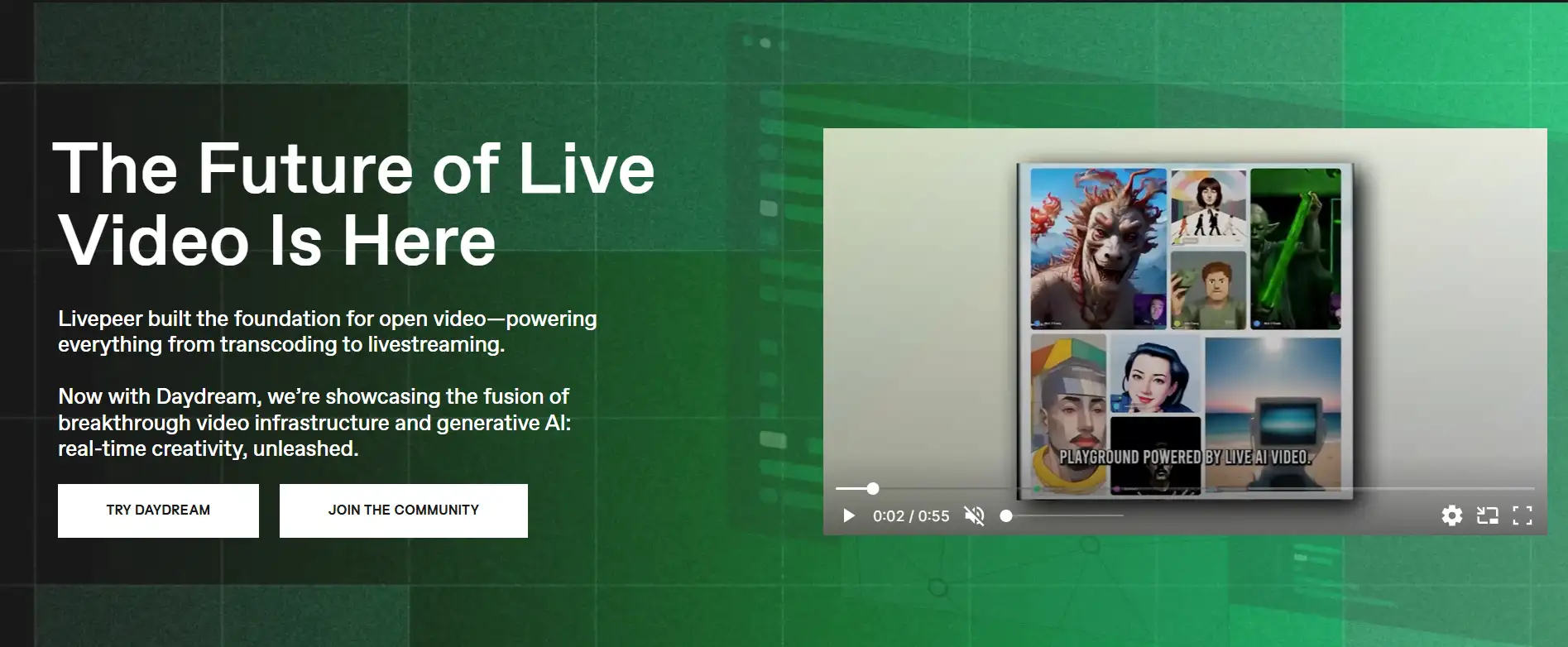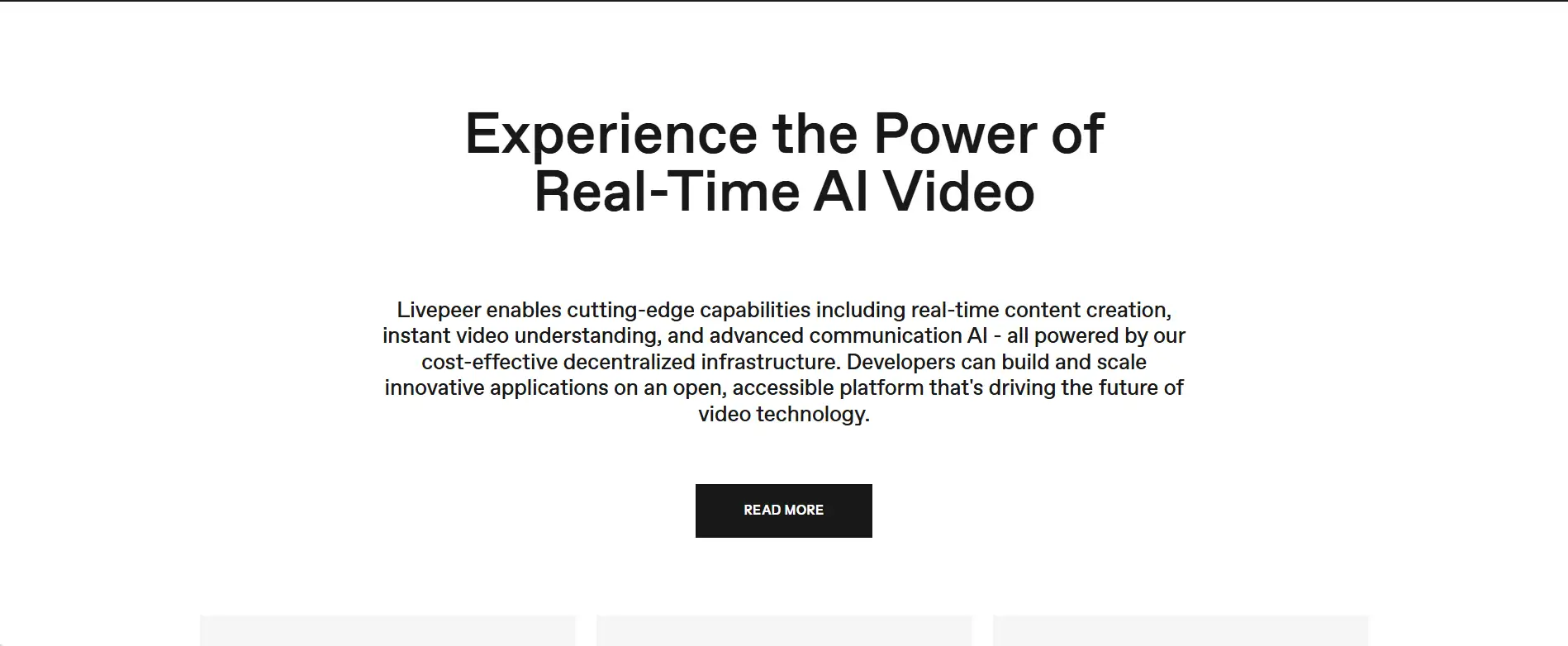About Livepeer
Livepeer is an innovative decentralized video infrastructure platform designed to make video streaming and AI-powered video processing more accessible, efficient, and scalable. The project’s mission is to provide developers, creators, and businesses with the tools they need to build modern, high-performance video applications without relying on costly, centralized providers. Through its global network of orchestrators, Livepeer offers a cost-effective and secure way to handle video transcoding, real-time AI processing, and creative media generation.
With the recent introduction of Daydream, Livepeer has expanded into the world of generative AI video, enabling real-time transformation of live camera inputs into animated visuals using text prompts. This new capability opens up endless possibilities for storytelling, marketing, and creative expression. Backed by an active, collaborative community, Livepeer continues to evolve as a leader in the Web3 video technology space, shaping the future of media creation and distribution.
Livepeer was founded with the vision of creating a more open, cost-efficient, and scalable alternative to traditional video streaming infrastructure. Unlike centralized solutions that require expensive servers and middlemen, Livepeer uses a decentralized network of orchestrators to perform critical tasks like video transcoding, distribution, and AI video processing. This approach reduces costs significantly while improving reliability and removing single points of failure.
The Livepeer Network works by allowing developers and creators to submit video streams to gateway nodes, which route jobs to orchestrator nodes for processing. Payments are handled through a micropayment system, where orchestrators are rewarded for their work. In addition to serving developers building live streaming platforms, virtual events, and media marketplaces, Livepeer is now at the forefront of real-time AI video innovation through its Daydream platform.
Daydream demonstrates how AI and decentralized infrastructure can combine to create entirely new categories of media experiences, from real-time artistic transformations to instant video understanding and interactive communication tools. This aligns with Livepeer’s broader ecosystem goals of empowering builders through open-source tools, developer grants, and community-driven governance.
Over the years, Livepeer has introduced numerous initiatives to grow its community and strengthen its technical foundation. The project actively supports developers through grant programs like the AI Startup Program and Video Disruptor Grant, while fostering engagement through governance proposals, ecosystem calls, and educational events. Competitors and comparable platforms in the decentralized video and streaming space include Theta Network, and Audius — although each has its own focus area, Livepeer distinguishes itself through its specialized emphasis on video infrastructure and AI integration.
Livepeer provides numerous benefits and features that position it as a leading force in the decentralized video technology space:
- Decentralized Video Infrastructure: A global network of orchestrators ensures security, scalability, and resilience while eliminating single points of failure.
- Real-Time AI Capabilities: Through its Daydream platform, Livepeer enables generative AI video creation, instant video understanding, and AI-driven communication.
- Cost-Effective Streaming: Significantly reduces transcoding and video distribution costs compared to centralized providers.
- Open-Source Development: Offers flexibility for developers to build, adapt, and scale video applications without vendor lock-in.
- Active Community & Governance: A thriving ecosystem of developers, creators, and AI innovators drives continuous improvement.
- Developer Grants & Support: Funding, mentorship, and resources to help builders bring cutting-edge video applications to life.
Getting started with Livepeer is straightforward, whether you want to build, orchestrate, delegate, or join the community:
- Build: Visit the Build on Livepeer page to access developer tools, APIs, and documentation. Explore guides to integrate video streaming and AI processing into your applications.
- Orchestrate: Run a node to perform transcoding and AI jobs for the network. Earn fees and rewards while contributing to infrastructure stability.
- Delegate: Stake your LPT to trusted orchestrators, enhancing network security and earning a portion of their fees and rewards.
- Participate in Governance: Join the community forum, vote on proposals, and contribute to network decision-making.
- Join the Community: Engage via Discord, Telegram, and other official channels to collaborate and stay updated.
Livepeer FAQ
Daydream, developed by Livepeer, uses generative AI models combined with the network’s decentralized GPU infrastructure to instantly process live camera feeds. When a user provides a text prompt, the system interprets it and applies real-time visual transformations to the incoming video stream. This allows creators to produce AI-enhanced storytelling, marketing visuals, or interactive media without the delay of offline rendering.
Orchestrators are the backbone of the Livepeer Network. They operate powerful GPU-equipped nodes that handle video transcoding, AI processing, and stream distribution. These orchestrators compete for jobs, execute them efficiently, and receive micropayments for their work. Their decentralized nature ensures resilience, scalability, and fault tolerance, making the network robust against downtime and central points of failure.
Yes, Livepeer provides developer SDKs, APIs, and open-source libraries like Livepeer.js that make it possible to integrate AI-powered video processing directly into existing streaming services. Developers can add real-time video transformations, enhance stream quality, and optimize delivery costs without rebuilding their entire infrastructure from scratch.
The micropayment system in Livepeer enables gateway nodes to send cryptographic payment tickets to orchestrators for completed video processing jobs. Winning tickets can be redeemed for payment, ensuring near-instant settlement. This system minimizes transaction fees, supports high-volume workloads, and ensures orchestrators are fairly compensated while keeping costs low for developers.
The Video Disruptor Grant offered by Livepeer supports experimental and cutting-edge video projects that leverage the network’s decentralized AI video infrastructure. Recipients have created interactive live shows, AI-driven visual effects pipelines, and innovative audience engagement tools. The goal is to encourage media innovation that pushes the boundaries of what’s possible with decentralized video technology.
You Might Also Like












